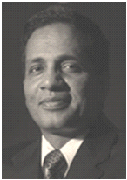by Lakshmanan Krishnamurti,
Pittsburgh, PA
Email Lakshmanan
 Lakshmanan Krishnamurti was born in the temple town of Madurai, India. He has lived in many places in India, first as the son of an Indian Air Force officer and then as a physician in the Indian Air Force. He moved to the US in 1993. He is currently a physician specializing in blood diseases, cancer and bone marrow transplantation in children.
Lakshmanan Krishnamurti was born in the temple town of Madurai, India. He has lived in many places in India, first as the son of an Indian Air Force officer and then as a physician in the Indian Air Force. He moved to the US in 1993. He is currently a physician specializing in blood diseases, cancer and bone marrow transplantation in children.
The article by Sridevi Rao James in the last issue raises important questions on how to sustain Hindu institutions in the United States. Rao James observes that as the first generation of founding Hindus slowly fades away, the mantle of leadership will have to pass to the next generation born and raised in the US. At first glance, this appears to be an obvious an inevitable change. However, public institutions are living organisms with a natural life cycle of growth, maturation, stagnation, even decay. They can also change course according to the people who participate and run these institutions. The composition of the worshippers and leadership of religious institutions set up by immigrant communities in the US will change over time. Many may even cease to function as the founding members of their congregation age and eventually fade away.
Ms. Rao James says, depending on only new Indian immigrants to take care of the temples is not only shortsighted but also likely to further alienate the already disengaged Hindu Indian-Americans born and raised here. The alienation of US born Indian-Americans from Indian immigrant students and their institutions is evident on university campuses. However, there is a distinction between college students who may be still grappling with their own identity and their need to fit in and adults who are trying to raise children in their own cultural traditions.
In Hindu temples across America, Indian immigrants, US-born Indian children and adults, American spouses, interracial children and some children and adults with no Indian heritage at all, all worship and participate in the various classes and activities, motivated by their interest in the Hindu tradition. That these individuals with diverse backgrounds are able to participate in the activities of the temple indicates that these institutions not only welcome people from different backgrounds, but also accept the attitudes and values people from diverse backgrounds.
If US-born Hindus overcome their reservations and become involved in these institutions, they will fit in very well..
There are however, many challenges that we face to make our institutions relevant and attractive to our young people. Attendance of children in Temples drops off after 10th grade though some young college students continue to attend. Hindu temples in the US are thriving largely because of the dedication of the large number of recent immigrants and the organic link they provide to India. However, the seemingly unending supply of immigrants from India is subject to change by social, political and economic forces.
While many Indian immigrants view their institutions through the prism of caste, region, language, and social mores as they existed at the time of their emigration from India, others are completely turned off by these.
For too many immigrants, the temple is merely a salve against social isolation and a means to get the acceptance they seek, but do not seem to get elsewhere.
As the new immigrants have struggled to adapt to the American mainstream, a whole generation of American-born Hindus have come of age. They take for granted the fruits of the struggles of their parents. Besides, youngsters, often pushed by their families to excel in school and at work, have had neither the time nor the opportunity to acquire more than a superficial familiarity with their culture and religion.
Many living in biracial and two-religion households may find the institutions of the non-Hindu/Indian half of their families more welcoming.
US-born Hindus may be different from their Indian born parents, but that does not make them less deserving of celebrating their religion, culture, and heritage. We ignore this shift in the demographics at the peril of losing the long-term viability of our institutions.
How do we attract and retain the interest of this generation? The
answer is astonishingly simple. We, who are rediscovering Hinduism in America, need to restore temples from their recent role as mere places of worship, to their traditional place as centers of social and cultural life of our communities. This holds the possibility that American-born Hindus will be drawn to these places during the different transitions in their lives. We must also actively recruit US born Hindus of every age to our temples, trust them, and give them responsibility of running it.
Like Rao James, I too believe it is time to be creative and thoughtful about how to bring our youth back into the fold. Otherwise, Hindu temples all across the US built with love by a whole generation of immigrants may survive only as museums.
Editor’s Note: We thank all the authors who came forward to share their thoughts and ideas on this thread of topic. This topic, we hear, has triggered lot of table-topic discussions in many homes and gatherings of our readers.
